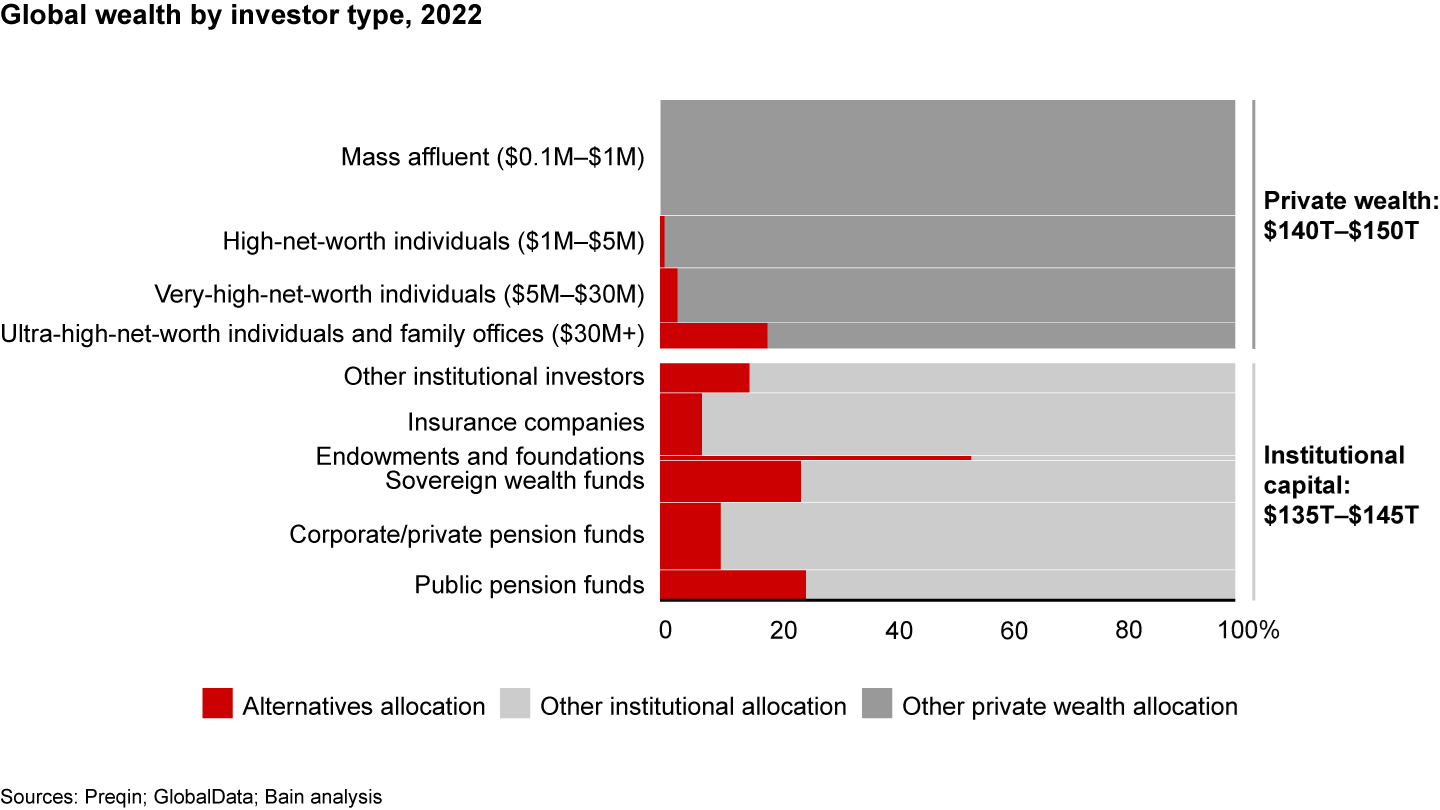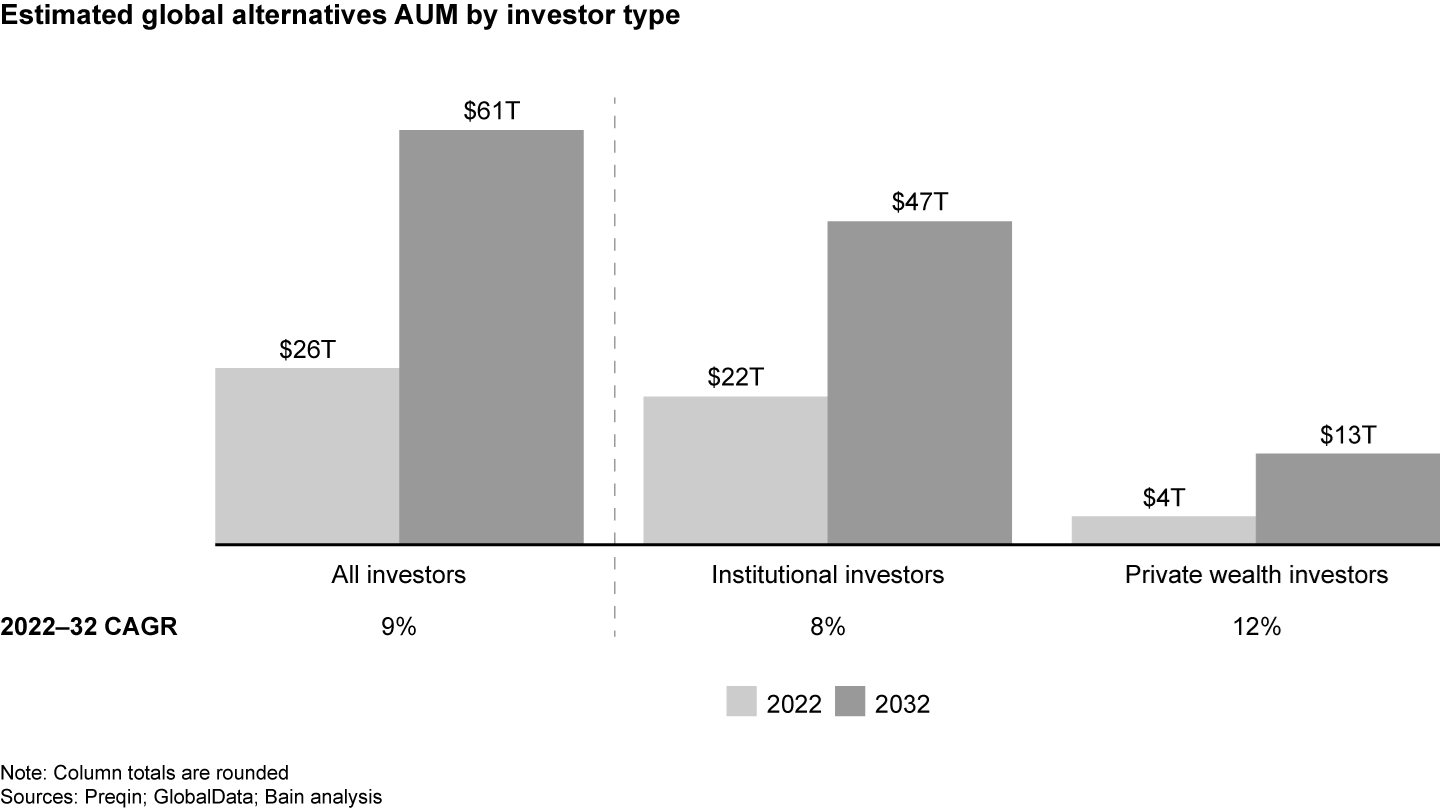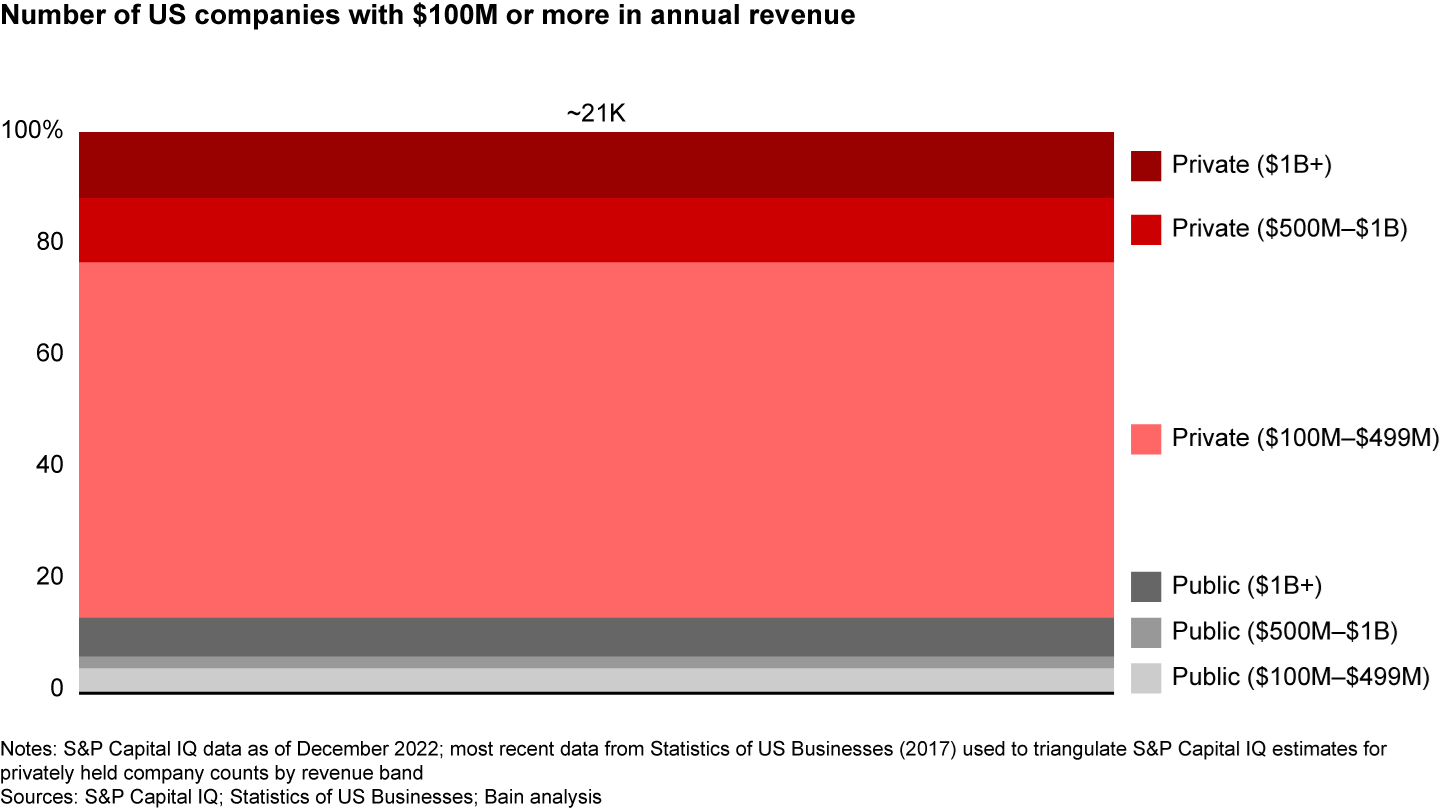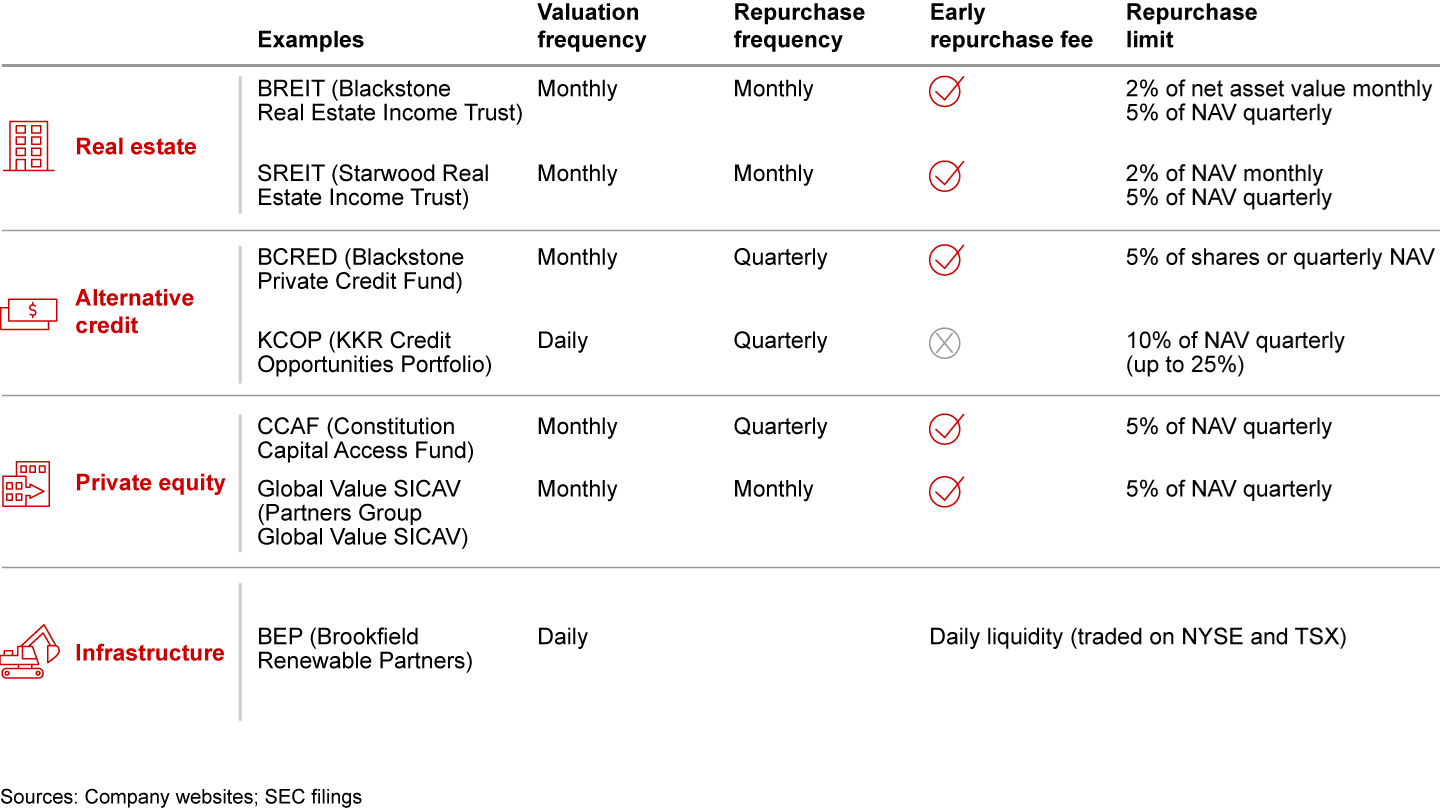Global Private Equity Report

Executive Summary
- Private equity firms, especially the largest ones, see a world of opportunity in structuring products to attract wealthy individual investors.
- Individuals, too, see a lot to like in the returns and diversification alternative investments can offer them.
- Interest from both sides—and fewer barriers keeping them apart—has led to plenty of experimentation. But the industry still has work to do if it wants to turn the retail market into a source of real growth.
This article is part of Bain’s 2023 Global Private Equity Report
It’s hardly mysterious that private equity sees individual investors as the next great growth engine.
The opportunity can be captured in two numbers: 50% and 16%. Individual investors hold roughly 50% of the estimated $275 trillion to $295 trillion of global assets under management (AUM). Yet those same investors represent just 16% of AUM held by alternative investment funds (see Figure 1).
Individual investors hold roughly half of all global wealth but account for a much smaller share of private capital AUM


This vast, untapped market has become increasingly attractive to alternative asset managers seeking to sustain double-digit growth even as the industry matures. The reverse is also true: Wealthy individuals (not to mention their advisers) are increasingly drawn to alternative investments as they look for new diversification options and better returns than they can get in the traditional markets for public equity and debt.
There is strong motivation on all sides to push the ball forward. Many of the largest alternative managers have launched funds providing high-net-worth individuals access to various alternative asset classes. Banks and advisers are exploring ways to add more alternative offerings for clients. And the fintech ecosystem is fast developing tools and solutions that could streamline distribution and make it more affordable.
What’s clear amid the experimentation, however, is that there’s nothing easy about it. Fund managers, financial advisers, and individuals all face a steep learning curve in making these new channels work at scale. When Blackstone met with significant redemptions in two groundbreaking retail funds last year, it highlighted the complexity of managing a large group of investors with very different liquidity expectations than the institutional investors PE firms are used to. It will take time for the industry to work through new market challenges like these while simultaneously developing the muscles to compete in an unfamiliar arena. Experience so far suggests the industry has yet to really crack the code on retail.
The growth (and diversification) imperative
To date, the largest fund managers have been leading the charge into retail markets because they have both the greatest need for new capital sources and the most resources to chase them. For public firms, management fee growth is strongly correlated with public market valuation. So, most of these giants aspire to expand fee-bearing AUM at double-digit rates into the foreseeable future—goals that will require an unprecedented volume of new fund-raising.
At the same time, however, it is unclear whether the industry’s traditional sources of fund-raising (large institutions) can continue to support that kind of growth. Bain & Company projects that institutional capital allocated to alternative investments will grow 8% annually over the next decade. Individual wealth invested in alternatives, meanwhile, is expected to grow 12% annually over that period, albeit from a much smaller base. Taken together, these sources would support 9% annual growth in AUM through 2032. That’s better than 8%, but still not a path to double-digit growth (see Figure 2).
Retail capital is expected to grow quickly, but it will have to grow faster still to meet industry growth aspirations


Consequently, the push to open access to more retail capital has become a high priority for some of the industry’s largest funds, many of which have set explicit ambitions for boosting individual investor AUM. Blackstone sees potential to expand retail capital from $200 billion to $500 billion, KKR expects between 30% and 50% of new capital raised over the next few years to come from the private wealth channel, and Apollo seeks to raise $50 billion in retail capital cumulatively from 2022 through 2026.
The question for the next tier is whether to follow suit. Many firms are reexamining their own growth and fund-raising ambitions—whether in relative or absolute terms—and asking if individual capital should play a role. There is no right answer; it depends on a firm’s specific funding strategy and objectives. But sensing a competitive shift, more and more firms are undertaking the analysis.
Increased access to private equity is also drawing keen interest from individuals and their advisers. Not only are private equity’s historically superior returns attractive (14% globally over the past 25 years vs. 7% for the MSCI World Index), but true diversification in the public markets has become harder to achieve over time.
The number of public companies has declined in recent decades, leaving public investors closed off from large parts of the global economy (see Figure 3). Movement in the S&P 500 has come to be dominated by a handful of very large technology companies. Moreover, the recent inflationary environment has made it difficult to hedge against downside risk through the traditional allocation formula of 60% stocks and 40% bonds. Prices for those two asset classes, which historically have moved in opposite directions, became positively correlated as rising interest rates triggered declines in equity prices during last year’s market rout.
Fewer than 15% of companies with revenue over $100 million are publicly held, giving public investors narrow exposure to the broader economy


Mixing in private assets would give advisers and their clients additional options for building portfolios that pair attractive returns with new forms of diversification. It could also provide new fee opportunities for the channel partners and digital platforms lining up to distribute these new products.
Receding barriers
The alternatives markets haven’t been closed off entirely to individual investors over the years. But entry has largely been limited to the highest end of the wealth scale due to a number of structural barriers—regulation, lack of access, economics, and liquidity constraints.
The financial industry divides the universe of individual investors into tiers based on wealth: ultra-high-net-worth individuals (those with more than $30 million in investable assets), very-high-net-worth (more than $5 million), and high-net-worth ($1 million to $5 million). Below these tiers is the mass affluent segment: individuals with meaningful portfolios but investable assets of less than $1 million. A substantial share of wealth in this mass affluent segment is invested in retirement plans.
Private equity has already made significant progress reaching individuals at the highest end of the spectrum ($100 million to $500 million-plus), and the mass affluent segment at the bottom is the most shielded by regulation. Consequently, the industry is focusing most of its attention on the large untapped market in the broad middle, using innovative fund structures and technology solutions designed to make the historical barriers less onerous.
Private equity is focusing on the broad middle of the retail market, using innovative fund structures and technology to make historical barriers less onerous.
Regulation. The impact of regulation on individual investors has been changing in two ways. First, rules defining who can and cannot invest in certain types of private funds have eased off somewhat in recent years. In 2020, for example, the US Securities and Exchange Commission broadened the definition of “accredited investor” beyond wealth-based criteria to include individuals with sufficient “knowledge and expertise” regarding an investment. Second, general partners (GPs) have been innovating steadily to structure funds that are both compliant with regulations and open to larger segments of the individual investor market.
Traditional buyout funds hoping to target the mass affluent market are still deterred by government guidance around the level and complexity of fee structures when serving this lower tier. But for higher wealth tiers, firms like Ares Management and Partners Group have opened doors to alternative asset classes by working within the Investment Company Act of 1940 to tailor funds aimed at different audiences, making trade-offs between access and fee limits. Real estate and credit funds have been particularly innovative.
The net result of rule changes and product innovation is that a growing number of individuals across regions are gaining access to more types of alternative investments.
Access. Private equity’s traditional focus on building lasting relationships with a relatively small cohort of large institutional investors means the industry has done little historically to create the distribution and marketing infrastructure required to reach individuals and build awareness with them. But that’s also changing as an ecosystem of intermediaries springs up to create channel partnerships and educate both advisers and individual investors on how alternative assets work.
Traditional wealth advisers like private banks and registered investment advisers are setting themselves up to distribute alternative investments to their clients. That not only gives them a broader menu of diversification options but also a substantial new stream of fee income.
The number of digital pathways, meanwhile, has exploded. Emerging digital players like Moonfare, iCapital, and Opto Investments have built platforms—some aimed at financial advisers, some aimed directly at individuals—that offer low-cost access to a wide range of alternative products.
Moonfare, for instance, is a fast-growing direct-to-consumer platform based in Berlin that offers self-certified investors access to PE funds by pooling individual investments. iCapital is a much larger firm based in New York that uses a similar pooling model to aggregate investments in buyout and other types of alternative investments. But it targets accredited investors through private banks like UBS. Opto Investments employs a model similar to iCapital’s but focuses on financial advisers rather than private banks. Notably, Opto offers software that supports back-office functions and investment decision making, which helps financial advisers manage the complexities of alternative asset classes.
As we discuss elsewhere in this report, the alternatives industry is also exploring how smart contracts and tokenization could potentially streamline these digital pathways. Firms like KKR and Hamilton Lane have launched tokenized fund structures that provide liquidity mechanisms for individuals. These models promise to cut administrative costs and improve economics for GPs, with the goal of lowering minimums and creating a retail-like user experience. The initiatives so far involve small slices of larger funds and are very much in the pilot stage. But they are generating wide interest among funds looking to build faster, more efficient bridges to the individual market.
Economics. Historically, the private equity industry’s steep investment minimums and high fees have worked with regulatory restrictions to put funds out of reach for most investors. But as the industry matures and scales, it should get cheaper for individuals to find a seat at the table.
Already, digital distribution platforms have exerted downward pressure on fees—the fees charged by private banks and financial advisory firms in the middle of the distribution channel, not those charged by PE funds themselves. As a result, GPs are more than happy to keep structuring low- (or lower-) minimum funds for individuals that draw in new fee-generating assets. The banks and advisory firms, meanwhile, are working on innovative ways to streamline and cut costs in their own operations.
Liquidity. The private equity investment model is geared toward very large, patient investors willing to lock up their money for a period of years before they see any distributions. So, it’s no surprise that liquidity is one of the biggest challenges GPs face in structuring investments for individuals. Some large product managers have developed funds that offer investors intermittent liquidity (see Figure 4). But even these structures pose significant challenges in managing investor expectations. And they create operational burdens not posed by closed-end funds.
Alternative managers have developed products across asset classes that provide some level of liquidity to investors


In courting the retail market, Blackstone’s BREIT fund made no secret of what the rules were around redemptions. The fund’s redemption limits of 2% of net asset value per month (5% per quarter) were designed to give individuals enough flexibility to access their principal when needed, despite relative illiquidity of the fund’s assets. Amid market jitters in late 2022, however, investors began to ask for their money back, threatening what amounted to a run on the bank. Blackstone had to enforce the redemption limits, raising concerns that the episode would slow down its retail strategy.
BREIT got a huge vote of confidence in January 2023 when the University of California pledged $4 billion to the fund. But the incident still stands as a prime example of how differently individuals view liquidity. Unlike institutional limited partners with virtually unlimited staying power, individuals are used to getting money out when they need it. They also aren’t particularly sympathetic to the fund’s broader cash flow concerns. This is unfamiliar terrain for fund managers, who can just pick up the phone and call limited partners when problems arise. That isn’t possible with a relatively anonymous group of individual investors numbering in the tens or hundreds of thousands.
Managing the liquidity needs of individual investors will inevitably require more trial and error by GPs. It will also mean building new capabilities in areas wholly unfamiliar (if not anathema) to most private equity firms: public relations, customer service, and traditional forms of marketing to a mass audience. To a large degree, individuals will simply have to learn that investing in relatively illiquid assets necessarily comes with its own set of risks, rewards, and restrictions. But the communication and education challenge this poses for funds—not to mention the investment it involves—can’t be underestimated.
One solution may have to come from the development of secondary markets in alternatives that individuals can tap when they need to. Digital players like Securitize and Moonfare are already probing this opportunity with new platforms creating “walled” mechanisms for secondary trading. Securitize, which has worked with a number of PE firms to tokenize fund units, has received SEC approval to act as a transfer agent, allowing it to operate a token exchange. Moonfare runs a formal process twice a year that gives retail investors the chance to trade ownership stakes in alternative asset funds. For investors who want to sell stakes outside of the semiannual process, Moonfare has teamed with Lexington Partners to provide liquidity in certain situations.
“Retail investors need access to liquidity mechanisms if we want to democratize private equity,” says Moonfare CEO Steffen Pauls.
Liquidity remains a problem for the industry to solve, but there is plenty of white space to go after in the meantime. Liquidity requirements decrease and sophistication tends to rise as you move up the wealth ladder. That means GPs have the opportunity to pursue high-net-worth individuals with offerings that feature more traditional liquidity constraints. Those investors already participate in the private markets to some degree, and new platforms like Titanbay broaden access. In the meantime, funds and their channel partners will undoubtedly work at a sprint to unstick the liquidity issue.
Implications for fund managers
Despite the growing pains, no one doubts that retail capital is gaining traction and will eventually be an important source of fund-raising for alternative managers. That will have broad implications across the industry.
While the biggest GPs are generating the most buzz across the retail segment at the moment, firms of all sizes are dipping a toe in with a variety of market plays (see Figure 5). It’s too early to identify winners and losers, but the diversity of approaches suggests there is no one-size-fits-all strategy.
Alternative asset managers are targeting individual capital using a variety of go-to-market plays, and some are pursuing more than one
In our experience, a strong retail strategy starts with defining a firm’s ambition and matching it to both the right customer segment and the most appropriate go-to-market strategy. It’s also essential to recognize that cracking the retail market will require skills and capabilities more common to a consumer products company than the average GP—branding, segmented marketing, product development, etc. That demands a clear-eyed assessment of what it will take to win in terms of capability building and operational support.
Market definition requires choices around a number of key considerations:
- Customer segment. What’s the trade-off between access and market size? A narrow focus on ultra-high-net-worth individuals may be easier to implement, but a broader focus lower down the wealth ladder could open up a larger pool of capital.
- Product offerings. Which of our asset classes makes sense based on the customer segment and regulatory considerations? Do we need to develop new fund structures, or will existing ones suffice?
- Distribution channel. What’s the best way to reach our desired customer? Firms are working through private banks, financial advisers, traditional asset managers, and emerging digital channels. They are also going direct.
- Coverage model. What’s our approach to marketing and sales? This, too, will depend on the channel, but some firms are standing up dedicated teams to build relationships with banks, advisers, and other intermediaries. Others are focusing on one or more of these channels with existing teams.
GPs of all sizes are pursuing innovative strategies to raise individual capital. A few of the largest, like Blackstone and KKR, have all-in strategies matched to their ambitious AUM growth targets. Both have developed a range of tailored retail products, including publicly traded vehicles. And they have geared up to establish momentum across almost every channel.
Apollo, meanwhile, has announced its ambitious Apollo Aligned Alternatives, which it describes as a “replacement for S&P core equity holdings.” It has the potential to be the largest fund on the Apollo platform in 2023. Constitution Capital has launched its Constitution Capital Access Fund, which is available to individuals with lower wealth levels who certify as “qualified clients.”
Blue Owl has found success targeting private banks and financial advisers. Its most recent $12.9 billion fund reports that more than 40% of its capital came from individual investors.
Firms are also rapidly adding capabilities to support these efforts. To cover financial advisers, Blackstone has assembled a team of 300 salespeople and created a training program on alternative investments. Ares acquired Black Creek Group’s US real estate advisory and distribution business to expand its retail capabilities, while Partners Group built a private wealth unit focused on private banks and financial advisers and has partnered with digital platforms like ADDX.
One reality any retail strategy has to face is that private equity and the broader alternatives industry lack both brand recognition and a clear understanding among many high-net-worth individuals of how the business model works. Ask a wealthy person who the big names in private equity are and “I don’t know” rises to the top, followed by large financial institutions such as Fidelity and Charles Schwab that barely have any presence in alternatives (see Figure 6).
A survey of wealthy individuals shows that most private capital firms float below the radar in terms of brand identity


This suggests that even firms with established relationships among banks and advisers have hardly scratched the surface in terms of brand building. Even tapping the very-high- and high-net-worth segments will take substantial investments in education, innovation, and distribution, and the mass affluent segment is a bridge further still. The more alternative managers move down the wealth ladder, the more they will compete with some of the best-known brands in finance. That will be especially true in the US if regulators provide clear access to 401(k) investors. These retail channels require robust customer service, public relations expertise, communications strategies, and other marketing-related muscles. It will take both resources and time to develop these capabilities.
The clock is ticking
Pursuing individual capital may not be the right approach for every firm. But given the momentum building in the retail market, there is growing urgency for any alternative manager interested in developing a strategy.
While the market is broad, many of the distribution channels are narrow, creating first-mover advantage. Private banking is a good example. This segment, which includes financial institutions like Morgan Stanley and Merrill Lynch, has a high concentration of wealth managed by a small set of banks. Research shows that each bank has room for 5 to 15 funds per asset class, and early entrants are already filling available “shelf space.” It’s also true that large traditional asset managers are moving into alternatives products through partnerships, acquisitions, and in-house development. Those opportunities won’t last forever.
The funds that have already jumped in are still exploring what works in retail, and there’s a lot of learning left to do. But they are moving quickly, guided by the conviction that they will need a new and very large pool of capital to fund their growth ambitions. That is forcing the issue for the rest of the industry. The time is now to start making choices about whether to get in the game and how to position your firm to win.